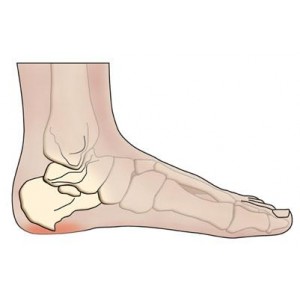Plantar Fasciitis and Heel Spurs
Plantar Fasciitis and Heel Spurs: Plantar fasciitis is an inflammation of the long band of connective tissue running from the heel to the ball of the foot.
Symptoms:Symptoms of plantar fasciitis can occur suddenly or gradually. When they occur suddenly, there is usually intense heel pain on taking the first morning steps, known as first-step pain. This heel pain often subsides as the patient begins to walk around, but it may return in the late afternoon or evening. When symptoms occur gradually, a more chronic form of heel pain causes patients to shorten their stride while running or walking. Patients also may shift the weight toward the front of the foot, away from the heel.
Causes:
Prevention:
Treatment:
Warning: We hope these suggestions improve your health and make you more comfortable. However, if you have any concerns about our advice, if any symptom persists for an unreasonable amount of time or if your condition worsens after self-treatment, we encourage you to consult a medical professional for further assistance.Please note, people with diabetes and poor circulation should always consult a medical professional before performing any self-treatment.
A Heel spur is a bony overgrowth on the bottom of the heel bone that results from tension and inflammation in the plantar fascia attachment to the heel.
Heel spur syndrome may be described as the combination of plantar fasciitis, tendonitis or stress with or without a plantar heel spur. Plantar fasciitis and heel spur syndrome affect women more than men. They can cause the bottom of the heel and arch to become painful.
Symptoms:Symptoms of plantar fasciitis can occur suddenly or gradually. When they occur suddenly, there is usually intense heel pain on taking the first morning steps, known as first-step pain. This heel pain often subsides as the patient begins to walk around, but it may return in the late afternoon or evening. When symptoms occur gradually, a more chronic form of heel pain causes patients to shorten their stride while running or walking. Patients also may shift the weight toward the front of the foot, away from the heel.
Causes:
- Stretching the long band of tissue that connects the heel and the ball of the foot
- Muscle imbalance
- Bone deformity
- Obesity
- Trauma
- Tightness of the muscles on the back of the leg
Prevention:
- Warm up and stretch properly before exercise
- Wear appropriate shoe gear
- "RICE" - rest, ice, compression, and elevation
Treatment:
- Wearing proper footwear for both everyday and sporting activities.
- Using insoles that support the arch and reduce tension on the ligament.
- Making use of an arch brace, arch bandage or arch cradle to relieve pressure and reduce inflammation of the plantar fascia at its attachment to the heel bone.
- Giving the afflicted area an ice massage to reduce inflammation and relieve tension.
- Stretching calf muscle to reduce tightness.
Warning: We hope these suggestions improve your health and make you more comfortable. However, if you have any concerns about our advice, if any symptom persists for an unreasonable amount of time or if your condition worsens after self-treatment, we encourage you to consult a medical professional for further assistance.Please note, people with diabetes and poor circulation should always consult a medical professional before performing any self-treatment.




